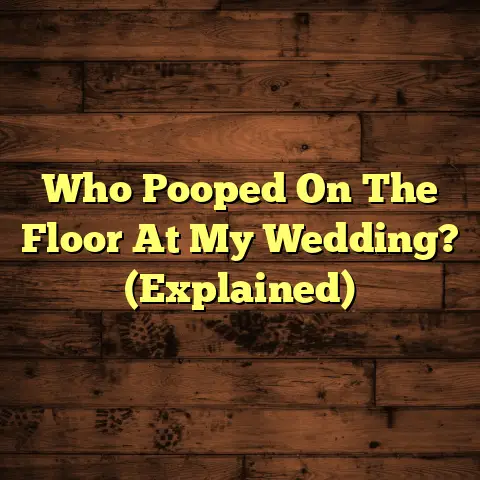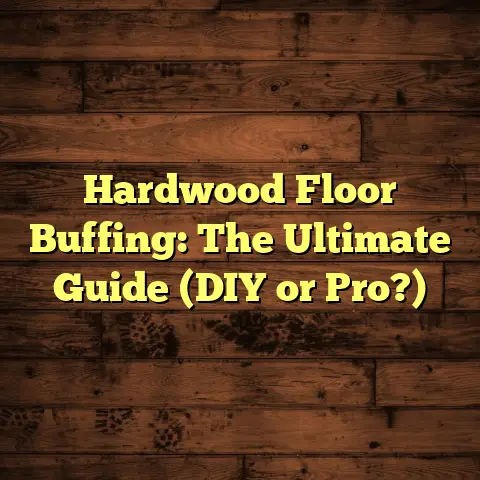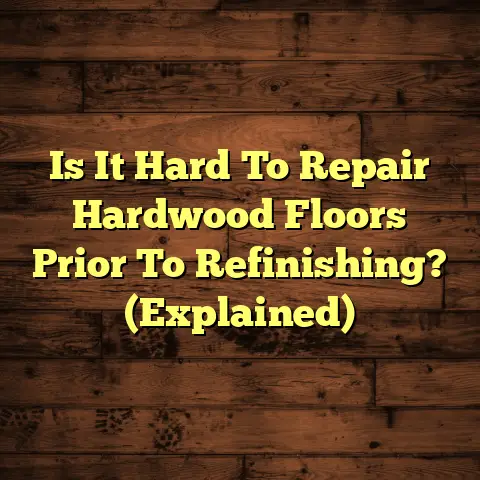Why Do Hardwood Floors Squeak? (1 Urgent Fix!)
Have you ever walked across your hardwood floors in the quiet of the night, only to be startled by the unexpected squeaks and creaks that seem to echo through your home?
It’s a sound that can instantly transform a serene atmosphere into one of mild annoyance, or even worse, a nagging worry about the condition of your beautiful hardwood.
Introduction
As a flooring contractor with years of experience, I’ve heard countless stories from homeowners just like you who are plagued by this common problem.
Squeaky floors aren’t just an auditory nuisance; they can also be a sign of underlying issues that, if left unaddressed, could lead to more significant problems down the road.
Think of it like this: that squeak is your floor trying to tell you something. It’s a cry for help, a subtle hint that something isn’t quite right beneath the surface.
While the reasons behind those squeaks can be varied and sometimes complex, understanding the root causes is the first step toward restoring peace and quiet to your home.
In this article, I’m going to walk you through the common culprits behind squeaky hardwood floors. We’ll delve into the natural characteristics of wood, explore the impact of installation techniques, and discuss how everyday wear and tear can contribute to the problem.
But more importantly, I’m going to equip you with a practical, urgent fix that you can implement yourself to alleviate those annoying squeaks.
This isn’t about a temporary patch or a quick fix that masks the issue. It’s about addressing the problem head-on with a solution that’s both effective and relatively simple to execute.
So, if you’re ready to silence those squeaky floors and reclaim the tranquility of your home, let’s dive in! I’m here to share my expertise and guide you through the process, step by step.
Section 1: Understanding Hardwood Floors
Before we can tackle the issue of squeaky floors, it’s crucial to understand the basics of hardwood flooring. What exactly is it made of? How is it constructed? And what are its inherent properties?
Knowing the answers to these questions will give you a solid foundation for diagnosing and addressing the root causes of those pesky squeaks.
1.1 Composition and Structure
Hardwood flooring, as the name suggests, is made from wood harvested from deciduous trees – trees that lose their leaves seasonally.
Common types of wood used for flooring include oak, maple, cherry, walnut, and hickory, each offering a unique blend of color, grain pattern, and hardness.
The Janka hardness scale is the industry standard for measuring the relative hardness of different wood species.
It measures the force required to embed a steel ball into the wood. The higher the number, the harder the wood.
| Wood Species | Janka Hardness |
|---|---|
| Brazilian Walnut (Ipe) | 3684 |
| Hickory | 1820 |
| Hard Maple | 1450 |
| Red Oak | 1290 |
| Cherry | 950 |
| Walnut | 1010 |
| Pine | 870 |
Source: https://www.nwfa.org/janka-hardness.aspx
Now, let’s talk about construction methods. There are two primary types of hardwood flooring: solid hardwood and engineered hardwood.
Solid hardwood is made from a single piece of wood, milled from a tree. It’s known for its durability and longevity, and it can be sanded and refinished multiple times over its lifespan.
Engineered hardwood, on the other hand, is constructed from multiple layers of wood veneer, bonded together with adhesive.
The top layer is a hardwood veneer, giving it the look and feel of solid hardwood. Engineered hardwood is more dimensionally stable than solid hardwood, making it less susceptible to warping and cupping in environments with fluctuating humidity levels.
Both solid and engineered hardwood flooring are typically installed over a subfloor, which is the structural foundation beneath the finished floor.
The subfloor is usually made of plywood or oriented strand board (OSB). The quality and condition of the subfloor play a crucial role in the stability and performance of the hardwood floor.
1.2 Common Characteristics of Hardwood Floors
One of the most important things to understand about hardwood is that it’s a natural material, and as such, it’s susceptible to changes in its environment.
Wood expands when it absorbs moisture and contracts when it dries out. This natural expansion and contraction can put stress on the flooring, leading to movement and, you guessed it, squeaks.
Humidity is a major factor in this process. In humid environments, hardwood floors tend to absorb moisture from the air, causing them to expand.
Conversely, in dry environments, they lose moisture and contract. These fluctuations can cause the wood to rub against the subfloor or adjacent boards, resulting in those telltale squeaks.
Temperature also plays a role. While not as significant as humidity, extreme temperature changes can also contribute to the expansion and contraction of hardwood floors.
For example, if you crank up the heat in the winter, the dry air can cause the wood to shrink.
Understanding these natural characteristics is essential for preventing and addressing squeaky floors. By controlling the humidity levels in your home and taking steps to minimize temperature fluctuations, you can help to maintain the stability of your hardwood floors and reduce the likelihood of squeaks.
Section 2: Why Do Hardwood Floors Squeak?
Now that we have a basic understanding of hardwood floors, let’s dive into the heart of the matter: why do they squeak?
The answer, as you might expect, is multifaceted. Squeaks can be caused by a variety of factors, ranging from the natural settling of a house to improper installation techniques.
Let’s explore some of the most common culprits behind those annoying squeaks.
2.1 Natural Causes of Squeaking
One of the most common reasons for squeaky floors is simply the natural settling of a house over time.
As a house ages, the foundation can shift slightly, and the wooden framing members can dry out and settle. This can cause the subfloor to move and rub against the hardwood flooring, resulting in squeaks.
Changes in humidity and temperature, as we discussed earlier, can also contribute to squeaking.
When the wood expands and contracts, it can put stress on the fasteners (nails or screws) that hold the flooring in place. Over time, these fasteners can loosen, allowing the wood to move and rub against the subfloor or adjacent boards.
Imagine a scenario where you live in an area with hot, humid summers and cold, dry winters. During the summer, your hardwood floors absorb moisture from the air and expand.
2.2 Installation Issues
Improper installation is another major cause of squeaky hardwood floors. If the flooring isn’t installed correctly, it can be prone to movement and squeaking.
One common mistake is inadequate nailing or gluing. If the fasteners aren’t spaced properly or if the adhesive isn’t applied evenly, the flooring may not be securely attached to the subfloor. This can allow the wood to move and rub against the subfloor, creating squeaks.
The subfloor itself also plays a critical role. If the subfloor is uneven, damaged, or not properly secured to the joists, it can cause the hardwood flooring to flex and squeak.
For example, if the subfloor is made of plywood and the seams between the sheets aren’t properly supported, the plywood can flex when you walk on it, causing the hardwood flooring above to squeak.
Another common installation mistake is failing to leave enough expansion space around the perimeter of the room. Hardwood floors need room to expand and contract with changes in humidity.
If the flooring is installed too tightly against the walls, it can buckle and squeak when it expands.
I remember one job where the homeowner had attempted to install the hardwood flooring themselves. They had done a decent job overall, but they hadn’t left enough expansion space around the edges of the room.
As a result, the flooring had buckled in several places, and the entire floor was a symphony of squeaks.
2.3 Wear and Tear
Over time, normal wear and tear can also lead to squeaky hardwood floors. Foot traffic, heavy furniture, and other stressors can gradually loosen the fasteners and cause the wood to shift and rub against the subfloor.
Areas of the floor that experience high traffic, such as hallways and doorways, are particularly vulnerable to squeaking. The constant pounding of feet can gradually weaken the fasteners and cause the wood to become loose.
Heavy furniture can also contribute to squeaking. When you place a heavy piece of furniture on a hardwood floor, it can compress the wood and put stress on the fasteners.
Over time, this can cause the fasteners to loosen and the wood to shift, resulting in squeaks.
I’ve seen cases where a homeowner had placed a large, heavy bookcase on a hardwood floor without proper support. The weight of the bookcase had caused the floor to sag slightly, and the entire area around the bookcase was riddled with squeaks.
2.4 Other Contributing Factors
While natural causes, installation issues, and wear and tear are the most common reasons for squeaky hardwood floors, there are a few other factors that can contribute to the problem.
Pests, such as termites or carpenter ants, can damage the wooden framing members of a house, weakening the subfloor and causing the hardwood flooring to squeak.
Moisture is another potential culprit. If water leaks into the subfloor, it can cause the wood to rot and weaken, leading to squeaks.
Even faulty plumbing can contribute to squeaking. If a pipe is leaking under the floor, it can saturate the subfloor and cause the hardwood flooring to swell and squeak.
Section 3: Diagnosing the Source of Squeaks
Okay, so you’ve got squeaky floors. Now what? The next step is to diagnose the source of the squeaks.
This can be a bit like detective work, but with a little patience and the right tools, you can usually pinpoint the problem area.
3.1 Identifying the Type of Squeak
Not all squeaks are created equal. Different types of squeaks can indicate different underlying issues.
Here are a few common types of squeaks and what they might tell you:
- Popping: This type of squeak often indicates that the hardwood flooring is rubbing against nails that have popped up slightly from the subfloor.
- Creaking: Creaking sounds often suggest that the subfloor is flexing or rubbing against the joists.
- Grinding: A grinding sound might indicate that there is dirt or debris between the hardwood flooring and the subfloor.
By paying attention to the type of squeak you’re hearing, you can narrow down the potential causes and focus your investigation.
3.2 Locating the Problem Area
Once you’ve identified the type of squeak, the next step is to locate the specific area of the floor that’s causing the noise.
This can be tricky, as sound can travel through the floor and make it difficult to pinpoint the exact location of the squeak.
Here are a few tips for locating the problem area:
- Walk slowly and deliberately across the floor, paying close attention to where the squeaks are most pronounced.
- Press down on the floor in different areas to see if you can reproduce the squeak.
- Look for signs of damage or instability, such as loose boards, gaps between boards, or areas where the floor feels soft or spongy.
Sometimes, the squeak may be coming from a nearby area. Try to isolate the sound as much as possible to pinpoint the exact source.
3.3 Tools and Techniques for Diagnosis
To help you diagnose the source of the squeaks, here are a few tools and techniques that I find useful:
- Flashlight: A flashlight can help you inspect the floor for signs of damage or instability. Shine the light at an angle to the floor to highlight any imperfections.
- Level: A level can help you determine if the subfloor is uneven. Place the level on the floor in different areas to check for dips or humps.
- Tap the floor: Tap the floor with your hand or a rubber mallet to listen for hollow sounds. A hollow sound can indicate that the flooring is not properly supported by the subfloor.
- Enlist a friend: Have a friend walk across the floor while you listen for the squeaks from below. This can help you pinpoint the exact location of the problem area.
I remember one instance where a homeowner was convinced that the squeak was coming from a specific spot in their living room.
However, after using a flashlight to inspect the floor more closely, I discovered that the squeak was actually originating from a loose board near the doorway, several feet away from where they thought the problem was.
Section 4: The Urgent Fix for Squeaky Hardwood Floors
Alright, you’ve identified the squeaky culprit. Now, let’s get to the good part: fixing it!
I’m going to share with you what I consider to be an “urgent fix” – a solution that’s relatively quick, easy to implement, and can provide immediate relief from those annoying squeaks.
4.1 Overview of the Urgent Fix
The urgent fix I’m going to recommend involves using shims to stabilize the subfloor from below.
Shims are thin, tapered pieces of wood or plastic that can be inserted into gaps to provide support and eliminate movement.
This method is particularly effective for addressing squeaks caused by a loose subfloor or joists. By inserting shims into the gaps between the subfloor and the joists, you can create a more solid connection and prevent the subfloor from flexing and squeaking.
This fix is considered “urgent” because it can be implemented quickly and doesn’t require any specialized tools or extensive demolition. It’s a great option for homeowners who want to address the squeaks without undertaking a major renovation.
4.2 Materials Needed
Before you get started, you’ll need to gather a few materials:
- Shims: You can purchase shims at most hardware stores. Wood shims are generally preferred, as they can be easily trimmed and shaped to fit the gaps.
- Wood glue: Wood glue will help to secure the shims in place.
- Utility knife or saw: You’ll need a utility knife or saw to trim the shims to the appropriate size.
- Hammer: A hammer may be needed to gently tap the shims into place.
- Safety glasses: Always wear safety glasses when working with tools to protect your eyes.
- Work gloves: Gloves will protect your hands from splinters and other potential hazards.
4.3 Step-by-Step Instructions
Now, let’s walk through the step-by-step instructions for implementing this urgent fix:
Step 1: Access the underside of the floor.
This fix requires access to the underside of the floor where the squeak is located. This usually means going into a basement or crawl space.
Step 2: Locate the squeaky area from below.
Have someone walk on the floor above while you observe from below. This will help you pinpoint the exact location of the squeak.
Step 3: Identify the gap.
Once you’ve located the squeaky area, look for a gap between the subfloor and the joist. This is where you’ll insert the shims.
Step 4: Apply wood glue to the shim.
Apply a generous amount of wood glue to one side of the shim.
Step 5: Insert the shim.
Insert the shim into the gap, with the glued side facing the subfloor. Gently tap the shim into place with a hammer until it’s snug but not overly tight.
Step 6: Trim the excess shim.
Use a utility knife or saw to trim off any excess shim that extends beyond the joist.
Step 7: Repeat as needed.
Repeat this process for any other gaps in the squeaky area.
Step 8: Allow the glue to dry.
Allow the wood glue to dry completely before walking on the floor above. This will ensure that the shims are securely in place.
4.4 Safety Precautions
Before you start working, it’s important to take a few safety precautions:
- Wear safety glasses to protect your eyes from flying debris.
- Wear work gloves to protect your hands from splinters and other potential hazards.
- Use caution when working with tools, and always follow the manufacturer’s instructions.
- If you’re working in a crawl space, be sure to wear a dust mask to protect yourself from dust and mold.
- If you’re not comfortable working under your house, consider hiring a professional to do the job.
Conclusion
So, there you have it! We’ve explored the common causes of squeaky hardwood floors, learned how to diagnose the source of the squeaks, and implemented an urgent fix that can provide immediate relief.
Remember, squeaky floors aren’t just an annoyance; they can also be a sign of underlying issues that need to be addressed.
By understanding the reasons behind those squeaks and taking action to fix them, you can protect your investment in your hardwood floors and ensure that they last for years to come.
I encourage you to take action if you’re experiencing squeaking in your own home. Don’t ignore the problem or assume that it will go away on its own.
A simple fix, like the one I’ve described in this article, can make a world of difference in the peace and quiet of your living environment.
And if you’re not comfortable tackling the project yourself, don’t hesitate to call a professional flooring contractor for assistance. We’re here to help you keep your floors in top condition and enjoy the beauty and comfort of your home.





